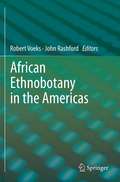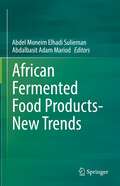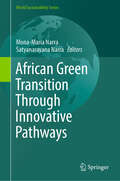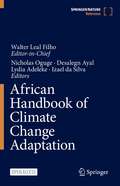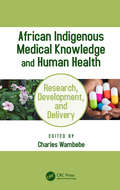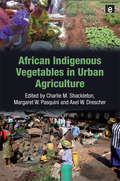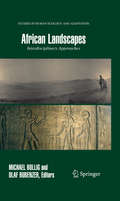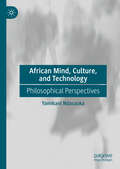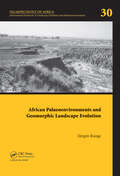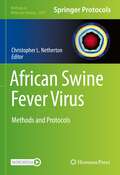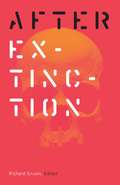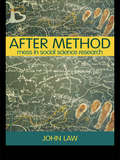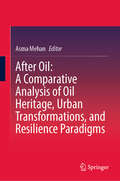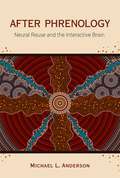- Table View
- List View
African Ethnobotany in the Americas
by Robert Voeks John RashfordAfrican Ethnobotany in the Americas provides the first comprehensive examination of ethnobotanical knowledge and skills among the African Diaspora in the Americas. Leading scholars on the subject explore the complex relationship between plant use and meaning among the descendants of Africans in the New World. With the aid of archival and field research carried out in North America, South America, and the Caribbean, contributors explore the historical, environmental, and political-ecological factors that facilitated/hindered transatlantic ethnobotanical diffusion; the role of Africans as active agents of plant and plant knowledge transfer during the period of plantation slavery in the Americas; the significance of cultural resistance in refining and redefining plant-based traditions; the principal categories of plant use that resulted; the exchange of knowledge among Amerindian, European and other African peoples; and the changing significance of African-American ethnobotanical traditions in the 21st century. Bolstered by abundant visual content and contributions from renowned experts in the field, African Ethnobotany in the Americas is an invaluable resource for students, scientists, and researchers in the field of ethnobotany and African Diaspora studies.
African Fermented Food Products- New Trends
by Abdalbasit Adam Mariod Abdel Moneim Elhadi SuliemanFermented foods play a major role in human nutrition and health, given the addition of flavor, improvement of texture, preservation against spoilage, and ease of digestion due to the fermentation process. This book provides information about the chemistry and bioactive compounds of African fermented food products, including their nutritional value and minor constituents. Chapters cover a wide range of topics, from the microorganisms involved in spontaneous fermentation to food safety considerations and quality assessment. The text can be used as a practical manual to better understand the nutritional and medicinal uses of various African fermented foods, as well as prepare recipes and product labels.
African Food Systems: Rethinking Prospects for Continental Sustainable Transformation
by Emmanuel NdhlovuThis book explores the evolving nature of food systems in Africa, which are at crisis point. The authors present case studies from across the continent to propose innovative and contextually relevant approaches to food systems resilience and food systems sustainable transformation. They investigate the contemporary challenges to food systems in Africa, including climate change, pandemics, energy challenges and war and conflict, inside and outside Africa. This book demonstrates how approaches to food can shift away from production, consumption and value chains toward safety, networks and complexity. This book brings new insight to the challenges in food systems from many disciplines, from agriculture, tourism, health, climate science, AI and digital science, political science and economics.
African Genesis
by Sally C. Reynolds Andrew GallagherThe discovery of the first species of African hominin, Australopithecus africanus, from Taung, South Africa in 1924, launched the study of fossil man in Africa. New discoveries continue to confirm the importance of this region to our understanding of human evolution. Outlining major developments since Raymond Dart's description of the Taung skull and, in particular, the impact of the pioneering work of Phillip V. Tobias, this book will be a valuable companion for students and researchers of human origins. It presents a summary of the current state of palaeoanthropology, reviewing the ideas that are central to the field, and provides a perspective on how future developments will shape our knowledge about hominin emergence in Africa. A wide range of key themes are covered, from the earliest fossils from Chad and Kenya, to the origins of bipedalism and the debate about how and where modern humans evolved and dispersed across Africa.
African Green Transition Through Innovative Pathways (World Sustainability Series)
by Mona-Maria Narra Satyanarayana NarraThis book provides a comprehensive analysis of Africa&’s evolving role in sustainable energy, focusing on waste management, renewable energy, and green hydrogen production. Featuring predominantly African-led research, it highlights cutting-edge innovations driving the continent&’s green transition. Drawing from research presented at the Second International Conference on Circular Economy, Renewable Energy, and Green Hydrogen in Lomé, Togo, in October 2024, the book explores key areas shaping Africa&’s energy landscape. It examines waste-to-energy technologies that transform waste into valuable resources, supporting both environmental sustainability and the circular economy. It also addresses the development of decentralized and hybrid renewable energy solutions designed to meet the growing demands of expanding urban populations. Additionally, it discusses the latest technological advancements, including predictive analytics and off-grid performance optimization, enhancing energy efficiency and system flexibility across the continent. Beyond technical advancements, the book explores the social and economic dimensions of sustainability, analyzing how green innovations drive economic growth, create jobs, and promote social equity. It serves as an essential resource for researchers, policymakers, and practitioners seeking insights into Africa&’s green transition and its increasing influence in the global shift toward sustainable energy solutions.
African Handbook of Climate Change Adaptation
by Nicholas Oguge Desalegn Ayal Lydia Adeleke Izael Da SilvaThis open access book discusses current thinking and presents the main issues and challenges associated with climate change in Africa. It introduces evidences from studies and projects which show how climate change adaptation is being - and may continue to be successfully implemented in African countries. Thanks to its scope and wide range of themes surrounding climate change, the ambition is that this book will be a lead publication on the topic, which may be regularly updated and hence capture further works.Climate change is a major global challenge. However, some geographical regions are more severly affected than others. One of these regions is the African continent. Due to a combination of unfavourable socio-economic and meteorological conditions, African countries are particularly vulnerable to climate change and its impacts. The recently released IPCC special report "Global Warming of 1.5º C" outlines the fact that keeping global warming by the level of 1.5º C is possible, but also suggested that an increase by 2º C could lead to crises with crops (agriculture fed by rain could drop by 50% in some African countries by 2020) and livestock production, could damage water supplies and pose an additonal threat to coastal areas. The 5th Assessment Report produced by IPCC predicts that wheat may disappear from Africa by 2080, and that maize— a staple—will fall significantly in southern Africa. Also, arid and semi-arid lands are likely to increase by up to 8%, with severe ramifications for livelihoods, poverty eradication and meeting the SDGs. Pursuing appropriate adaptation strategies is thus vital, in order to address the current and future challenges posed by a changing climate. It is against this background that the "African Handbook of Climate Change Adaptation" is being published. It contains papers prepared by scholars, representatives from social movements, practitioners and members of governmental agencies, undertaking research and/or executing climate change projects in Africa, and working with communities across the African continent. Encompassing over 100 contribtions from across Africa, it is the most comprehensive publication on climate change adaptation in Africa ever produced.
African Indigenous Medical Knowledge and Human Health
by Charles WambebeDespite the relevance of and empirical evidence for African Traditional Medicine, based on African Indigenous Medical Knowledge (AIMK), research and development of new phytomedicines from this continent has been slow. African Indigenous Medical Knowledge and Human Health aims to provide a catalyst for health innovations based on the rich African biodiversity and AIMK. The book documents some of the success stories from the continent related to AIMK and serves as a one-step reference for all professionals interested in the research and development of medical interventions - including pharmacognosists, ethnobiologists, botanists, phytochemists, pharmacologists and medical scientists.
African Indigenous Vegetables in Urban Agriculture
by Charlie M. Shackleton Margaret W. Pasquini Axel W. DrescherThis book provides a comprehensive synthesis of current knowledge of the potential and challenges associated with the multiple roles, use, management and livelihood contributions of indigenous vegetables in urban agriculture in sub-Saharan Africa. There has been growing research and policy effort around urban agriculture in the region over the last two decades, but never has it been integrated with work on under-researched crops such as indigenous vegetables. These species have multiple advantages, including low input requirements, adaptability to African environments, high nutritional value and marked biodiversity, cultural and local food security significance. Yet they are overlooked in the modern world, where recent emphasis has been directed to growing a limited range of exotic crops, both for internal markets and for export to developed country markets. This book provides evidence that, in spite of this neglect, in many African cities indigenous vegetables are still widely used, cultivated and marketed. It goes on to consider their potential to contribute to income generation and poverty alleviation of the growing numbers of urban dwellers in sub-Saharan Africa, whilst promoting urban greening and sustainability. Based on critical analysis of the debates it presents a multidisciplinary analysis of the realities and future opportunities.
African Landscapes: Interdisciplinary Approaches (Studies in Human Ecology and Adaptation #4)
by Michael Bollig Olaf BubenzerLandscape studies provide a crucial perspective into the interaction between humans and their environment, shedding insight on social, cultural, and economic topics. The research explores both the way that natural processes have affected the development of culture and society, as well as the ways that natural landscapes themselves are the product of historical and cultural processes. Most previous studies of the landscape selectively focused on either the natural sciences or the social sciences, but the research presented in African Landscapes bridges that gap. This work is unique in its interdisciplinary scope. Over the past twelve years, the contributors to this volume have participated in the collaborative research center ACACIA (Arid Climate Adaptation and Cultural Innovation in Africa), which deals with the relationship between cultural processes and ecological dynamics in Africa's arid areas. The case studies presented here come from mainly Sahara/Sahel and southwestern Africa, and are all linked to broader discussions on the concept of landscape, and themes of cultural, anthropological, geographical, botanical, sociological, and archaeological interest. The contributions in this work are enhanced by full color photographs that put the discussion in context visually.
African Mind, Culture, and Technology: Philosophical Perspectives
by Yamikani NdasaukaThis book provides a philosophical investigation of technology in Africa, articulating conceptual foundations and analyses rooted in African worldviews and communitarian values. It aims to spur discourse and understanding of how technology can be justly shaped for human advancement in Africa. Yamikani Ndasauka highlights the need to understand African conceptions of existence, ethics, and values as foundations for envisioning more humanistic technological applications. A historical contextualisation traces the layered origins of African technology philosophy in indigenous innovation, resistant adaptation of external systems, and creative fusion of endogenous and exogenous knowledge. The book develops African frameworks to assess and design technology in accord with human dignity and collective advancement.
African Palaeoenvironments and Geomorphic Landscape Evolution: Palaeoecology of Africa Vol. 30, An International Yearbook of Landscape Evolution and Palaeoenvironments (Palaeoecology of Africa)
by Jürgen RungeThis 30st jubilee volume (2010) of "Palaeoecology of Africa" looks back and reflects the "state of the art" of what is actually known on former African climates and ecosystems in the format of review articles authored by specialists in the field. New research articles on climate and ecosystem dynamics as well as applied topics on geomorphic ha
African Swine Fever Virus: Methods and Protocols (Methods in Molecular Biology #2503)
by Christopher L. NethertonThis volume provides a compilation of methods that will aid researchers studying virology, immunology, and vaccinology of this devastating disease of swine. Written in the format of the highly successful Methods in Molecular Biology series, each chapter includes an introduction to the topic, lists necessary materials and reagents, includes tips on troubleshooting and known pitfalls, and step-by-step, readily reproducible protocols. Authoritative and cutting-edge, African Swine Fever Virus: Methods and Protocols aims to be a foundation for future studies and to be a source of inspiration for new investigations in the field.
African Women in the Fourth Industrial Revolution: Change, Policies, and Approaches (Routledge Studies on Gender and Sexuality in Africa)
by Tinuade Adekunbi Ojo and Bhaso NdzendzeThis book investigates how women in Africa are being impacted by the Fourth Industrial Revolution, which describes the twenty-first-century proliferation of mobile internet, machine learning and artificial intelligence.The move towards digitalization brings fundamental changes in the way people work, live and generally relate to each other. However, in many areas of Africa, women face digital inclusion challenges, and their lack of access to the internet limits their social, political and economic participation in globalization. This book considers the different policy approaches taken in African countries, and their preparedness for enabling women’s participation in the Fourth Industrial Revolution, across a range of sectors.By diiscussing key topics such as artificial intelligence, technological adaptation, drones, entrepreneurship, education and financial inclusion, the book identifies positive policy approaches to ensure equitable progress towards the fourth industrial revolution at all structural levels.Making a powerful case for the benefits of inclusive digital innovation, this book will be of interest to researchers of women and technology in Africa.
African-American Astronauts
by Stanley P. Jones L. Octavia TrippDescribes the lives and accomplishments of five African-American astronauts including Guion S. Bluford Jr., Charles F. Bolden Jr., Frederick D. Gregory, Bernard A. Harris Jr., and Mae C. Jemison.
African-American Inventors: Lonnie Johnson, Frederick Mckinley Jones, Marjorie Stewart Joyner, Elijah Mccoy, Garrett Augustus Morgan
by Fred M. B. AmramProvides biographical profiles of five African American inventors including Lonnie Johnson, Frederick McKinley Jones, Marjorie Stewart Joyner, Elijah McCoy, and Garrett Augustus Morgan.
After Apollo?
by John M. LogsdonOnce the United States landed on the moon in July 1969, it was up to President Nixon to decide what to do in space after Apollo. This book chronicles the decisions he made, including ending space exploration and approving the space shuttle. Those decisions determined the character of the US human space flight program for the next forty years.
After Cooling: On Freon, Global Warming, and the Terrible Cost of Comfort
by Eric Dean WilsonThis dazzlingly original work of literary nonfiction interweaves the science and history of the powerful refrigerant (and dangerous greenhouse gas) Freon with a haunting meditation on how to live meaningfully and morally in a rapidly heating world.In After Cooling, Eric Dean Wilson braids together air-conditioning history, climate science, road trips, and philosophy to tell the story of the birth, life, and afterlife of Freon, the refrigerant that ripped a hole larger than the continental United States in the ozone layer. As he traces the refrigerant&’s life span from its invention in the 1920s—when it was hailed as a miracle of scientific progress—to efforts in the 1980s to ban the chemical (and the resulting political backlash), Wilson finds himself on a journey through the American heartland, trailing a man who buys up old tanks of Freon stockpiled in attics and basements to destroy what remains of the chemical before it can do further harm. Wilson is at heart an essayist, looking far and wide to tease out what particular forces in American culture—in capitalism, in systemic racism, in our values—combined to lead us into the Freon crisis and then out. It&’s a story that offers a rare glimpse of environmental hope, suggesting that maybe the vast and terrifying problem of global warming is not beyond our grasp to face.
After Dark: Poems about Nocturnal Animals
by David L. HarrisonThis collection of twenty-two poems explores the fascinating lives of North American nocturnal animals.When the sun goes down, many animals come out. Crickets chirp their crickety song hoping to attract a mate. Cougars bury their leftovers for later, leaving few clues for others to follow. Armadillos emerge from their dens to dig for worms, leaving holes in the lawns they disturb. This collection of poetry from acclaimed children's author and poet David L. Harrison explores the lives of animals who are awake after dark. Stephanie Laberis's beautifully atmospheric illustrations will draw in readers, and extensive back matter offers more information about each animal.
After Eden: The Evolution of Human Domination
by Kirkpatrick SaleWhen did the human species turn against the planet that we depend on for survival? Human industry and consumption of resources have altered the climate, polluted the water and soil, destroyed ecosystems, and rendered many species extinct, vastly increasing the likelihood of an ecological catastrophe. How did humankind come to rule nature to such an extent? To regard the planet's resources and creatures as ours for the taking? To find ourselves on a seemingly relentless path toward ecocide?In After Eden, Kirkpatrick Sale answers these questions in a radically new way. Integrating research in paleontology, archaeology, and anthropology, he points to the beginning of big-game hunting as the origin of Homo sapiens' estrangement from the natural world. Sale contends that a new, recognizably modern human culture based on the hunting of large animals developed in Africa some 70,000 years ago in response to a fierce plunge in worldwide temperature triggered by an enormous volcanic explosion in Asia. Tracing the migration of populations and the development of hunting thousands of years forward in time, he shows that hunting became increasingly adversarial in relation to the environment as people fought over scarce prey during Europe's glacial period between 35,000 and 10,000 years ago. By the end of that era, humans' idea that they were the superior species on the planet, free to exploit other species toward their own ends, was well established.After Eden is a sobering tale, but not one without hope. Sale asserts that Homo erectus, the variation of the hominid species that preceded Homo sapiens and survived for nearly two million years, did not attempt to dominate the environment. He contends that vestiges of this more ecologically sound way of life exist today--in some tribal societies, in the central teachings of Hinduism and Buddhism, and in the core principles of the worldwide environmental movement--offering redemptive possibilities for ourselves and for the planet.
After Eunuchs: Science, Medicine, and the Transformation of Sex in Modern China
by Howard ChiangFor much of Chinese history, the eunuch stood out as an exceptional figure at the margins of gender categories. Amid the disintegration of the Qing Empire, men and women in China began to understand their differences in the language of modern science. In After Eunuchs, Howard Chiang traces the genealogy of sexual knowledge from the demise of eunuchism to the emergence of transsexuality, showing the centrality of new epistemic structures to the formation of Chinese modernity.From anticastration discourses in the late Qing era to sex-reassignment surgeries in Taiwan in the 1950s and queer movements in the 1980s and 1990s, After Eunuchs explores the ways the introduction of Western biomedical sciences transformed normative meanings of gender, sexuality, and the body in China. Chiang investigates how competing definitions of sex circulated in science, medicine, vernacular culture, and the periodical press, bringing to light a rich and vibrant discourse of sex change in the first half of the twentieth century. He focuses on the stories of gender and sexual minorities as well as a large supporting cast of doctors, scientists, philosophers, educators, reformers, journalists, and tabloid writers, as they debated the questions of political sovereignty, national belonging, cultural authenticity, scientific modernity, human difference, and the power and authority of truths about sex. Theoretically sophisticated and far-reaching, After Eunuchs is an innovative contribution to the history and philosophy of science and queer and Sinophone studies.
After Extinction (21st Century Studies #6)
by Ashley Dawson Joseph Masco William E. Connolly Jussi Parikka Cary Wolfe Nicholas Mirzoeff Margaret Noodin Bernard C. Perley Claire Colebrook Joanna Zylinska Daryl BaldwinA multidisciplinary exploration of extinction and what comes next What comes after extinction? Including both prominent and unusual voices in current debates around the Anthropocene, this collection asks authors from diverse backgrounds to address this question. After Extinction looks at the future of humans and nonhumans, exploring how the scale of risk posed by extinction has changed in light of the accelerated networks of the twenty-first century. The collection considers extinction as a cultural, artistic, and media event as well as a biological one. The authors treat extinction in relation to a variety of topics, including disability, human exceptionalism, science-fiction understandings of time and posthistory, photography, the contemporary ecological crisis, the California Condor, systemic racism, Native American traditions, and capitalism.From discussions of the anticipated sixth extinction to the status of writing, theory, and philosophy after extinction, the contributions of this volume are insightful and innovative, timely and thought provoking. Contributors: Daryl Baldwin, Miami U; Claire Colebrook, Pennsylvania State U; William E. Connolly, Johns Hopkins U; Ashley Dawson, CUNY Graduate Center; Joseph Masco, U of Chicago; Nicholas Mirzoeff, New York U; Margaret Noodin, U of Wisconsin–Milwaukee; Jussi Parikka, U of Southampton; Bernard C. Perley, U of Wisconsin–Milwaukee; Cary Wolfe, Rice U; Joanna Zylinska, Goldsmiths, U of London.
After Method: Mess in Social Science Research (International Library of Sociology)
by John LawJohn Law argues that methods don't just describe social realities but are also involved in creating them. The implications of this argument are highly significant. If this is the case, methods are always political, and it raises the question of what kinds of social realities we want to create. Most current methods look for clarity and precision. It is usually said that only poor research produces messy findings, and the idea that things in the world might be fluid, elusive, or multiple is unthinkable. Law's startling argument is that this is wrong and it is time for a new approach. Many realities, he says, are vague and ephemeral. If methods want to know and help to shape the world, then they need to reinvent themselves and their politics to deal with mess. That is the challenge. Nothing less will do.
After Oil : A Comparative Analysis of Oil Heritage, Urban Transformations, and Resilience Paradigms
by Asma MehanThis book offers an academic analysis of the concept of heritage within the realm of oil-related urban development. It focuses on the term 'heritage', with a specific emphasis on 'oil heritage', exploring its varied implications for urban futures. The book provides a nuanced understanding of heritage, discussing its different interpretations and values across cultural and environmental contexts. It examines the legacy of oil, assessing its role and impact on societies. It presents a balanced view, acknowledging both the economic benefits of oil in urban growth and the environmental and socio-economic issues it poses. This approach places oil heritage within a broader heritage context, critically evaluating its unique characteristics. The book also investigates how various cultures perceive and engage with the idea of oil heritage. It highlights the contrast between the political debates over oil in Western countries and the developmental challenges faced by emerging economies, showcasing the global variance in the concept of 'oil heritage'. Additionally, the narrative considers the changing role and meaning of oil over time, reflecting on its historical importance and the challenges it poses for the future, especially in transitioning to a post-oil era. Through its chapters, the book provides a critical examination of the interplay between oil, urban development, and heritage studies. It is designed to contribute to scholarly discourse in these areas, targeting academics, students, policymakers, and professionals interested in the intricate relationship between oil heritage and urban dynamics.
After Parmenides: Idealism, Realism, and Epistemic Constructivism
by Tom RockmoreEngages with one of the oldest philosophical problems—the relationship between thought and being—and offers a fresh perspective with which to approach the long history of this puzzle. In After Parmenides, Tom Rockmore takes us all the way back to the beginning of Western philosophy, when Parmenides asserted that thought and being are the same. This idea created a division between what the mind constructs as knowable entities and the idea that there is also a mind-independent real, which we can know or fail to know. Rockmore argues that we need to give up on the idea of knowing the real as it is, and instead focus on the objects of cognition that our mind constructs. Though we cannot know mind-independent objects as they “really” are, we can and do know objects as they appear to us.After Parmenides charts the continual engagement with these ideas of the real and the knowable throughout philosophical history from Plato and Aristotle to Descartes, Kant, Fichte, Hegel, Schopenhauer, Marx, and others. This ambitious book shows how new connections can be made in the history of philosophy when it is reread through a new lens.
After Phrenology
by Michael L. AndersonThe computer analogy of the mind has been as widely adopted in contemporary cognitive neuroscience as was the analogy of the brain as a collection of organs in phrenology. Just as the phrenologist would insist that each organ must have its particular function, so contemporary cognitive neuroscience is committed to the notion that each brain region must have its fundamental computation. In After Phrenology, Michael Anderson argues that to achieve a fully post-phrenological science of the brain, we need to reassess this commitment and devise an alternate, neuroscientifically grounded taxonomy of mental function. Anderson contends that the cognitive roles played by each region of the brain are highly various, reflecting different neural partnerships established under different circumstances. He proposes quantifying the functional properties of neural assemblies in terms of their dispositional tendencies rather than their computational or information-processing operations. Exploring larger-scale issues, and drawing on evidence from embodied cognition, Anderson develops a picture of thinking rooted in the exploitation and extension of our early-evolving capacity for iterated interaction with the world. He argues that the multidimensional approach to the brain he describes offers a much better fit for these findings, and a more promising road toward a unified science of minded organisms.
